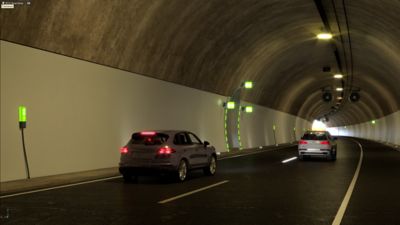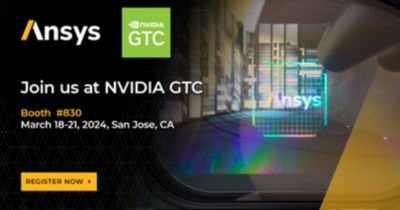-
United States -
United Kingdom -
India -
France -
Deutschland -
Italia -
日本 -
대한민국 -
中国 -
台灣
-
Ansys is committed to setting today's students up for success, by providing free simulation engineering software to students.
-
Ansys is committed to setting today's students up for success, by providing free simulation engineering software to students.
-
Ansys is committed to setting today's students up for success, by providing free simulation engineering software to students.
-
Contact Us -
Careers -
Students and Academic -
For United States and Canada
+1 844.462.6797
ANSYS BLOG
March 12, 2024
Narrow the Gap Between Simulation and Reality with Ansys at NVIDIA GTC
Visit us in booth 830 at NVIDIA GTC, a global artifical intelligence (AI) conference running March 18-21 at the San Jose Convention Center, or join virtually to see how Ansys simulation solutions use AI and accelerated computing to provide unprecedented speed, so that you can make better engineering decisions, faster.
Simulate Autonomous Driving
Among the 800 sessions at GTC, don’t miss “Driving Autonomous Vehicles in the Omniverse,” presented by Emmanuel Follin, a senior product manager at Ansys, at 5:15 p.m. PDT on March 18. Follin will share how Ansys AVxcelerate Autonomy sensor simulation is integrated with the NVIDIA DRIVE Sim platform to evaluate sensors and perception systems in diverse scenarios. AVxcelerate Autonomy is an end-to-end safety-driven solution designed to streamline advanced driver-assistance systems and autonomous vehicle (ADAS/AV) development.
This integration provides high-fidelity sensor simulation outputs generated with Ansys AVxcelerate Sensors for AV training and validation. AVxcelerate Sensors will augment NVIDIA DRIVE Sim with Ansys’s predictively accurate physics solvers for camera, lidar, and radar sensors. Follin will explore ways Ansys is using OpenUSD and NVIDIA Omniverse, a development platform for connecting and developing OpenUSD applications, to help unlock unprecedented possibilities in simulation and visualization.
OpenUSD, or Universal Scene Description, is an extensible framework and universal interchange between 3D and simulation data tools and ecosystems. Ansys is using these cutting-edge technologies to deliver new capabilities that will enhance the accuracy, efficiency, and realism of virtual prototypes and provide immense value to customers across industries by narrowing the gap between reality and simulation.

Run large-scale, physically accurate multi-sensor simulations with Ansys powered by NVIDIA Omniverse.
Continuing the theme of autonomous driving, Lionel Bennes, a lead product manager at Ansys, will present “Enhancing AI-Based Perception Testing with Radar Sensor Simulation.” The session, which takes place March 20 at 2 p.m. PDT, explains how Level 3 and above autonomous driving requires comprehensive testing and validation. Level 3 autonomy, also known as conditional driving automation, has proven difficult to achieve in the real world. Level 3 autonomous vehicles use sensors and AI to detect and respond to environmental conditions.
This could enable a car to accelerate past a slow-moving vehicle, park, maintain safe distances from other vehicles, exit a freeway, and perform other common driving tasks. However, the driver still needs to be ready to intervene. Bennes’ session will show how high-fidelity sensor simulation for radar is critical for autonomous vehicle perception development. He will explain how physics-based solutions such as AVxcelerate and NVIDIA DRIVE Sim help enable developers to evaluate their perception systems in diverse scenarios and generate synthetic data to tailor testing. Because sensor simulation operates in real time, this approach can be deployed for both software-in-the-loop and hardware-in-the-loop testing.
GPUs Light Up Simulation Speeds
Kenneth Weselake, a project leader at BMW, will join Mathieu Reigneau, a senior product manager at Ansys, in an on-demand presentation at GTC that will explain the benefits of simulating light using graphics processing units (GPUs). The session, titled “Advancing Innovation in Accurate Simulation of the Light With GPU Computation,” covers how Ansys adapted our current CPU solvers into scalable, general-purpose solvers, accelerated by NVIDIA GPUs. Computing the equations of optics and photonics simulation requires extreme power, which could equate to long compute times. GPUs reduce the calculation times for simulating photons’ paths and energy. The presenters will also illustrate how GPU-supported simulation transforms innovation beyond acceleration, enabling you to address new challenges within reasonable deadlines and explore more “what-if'” scenarios.
Digging deeper into ray tracing, the session on “Accelerating Ansys HFSS Ray-Tracing (SBR+) Simulations with NVIDIA Professional GPUs” research by Laila Salman, a principal application specialist at Ansys, will be available at GTC. Ansys HFSS SBR+ is a high-frequency electromagnetic solver engine for modeling installed performance of antennas and signal propagation in large environments. Applications include integrated antenna performance on large vehicles and buildings, antenna-to-antenna proximity coupling effects, radar cross section modeling for large target radar signatures, and indoor/outdoor wireless channel modeling in dynamic, bespoke environments. Salman’s work shows how HFSS SBR+ with NVIDIA accelerated computing can help deliver engineering insights in record time.

Ansys RF Channel Modeler offers a fully digital workflow to address the needs of today’s most complex RF systems designs.
Visit our booth at GTC to learn more about how to leverage HFSS SBR+ simulation via cloud computing using Ansys Gateway powered by AWS. You can also get a sneak peek at new Ansys solutions, including Ansys Perceive EM and Ansys RF Channel Modeler, which can be used with NVIDIA Omniverse. Perceive EM uses a GPU-based shooting and bouncing ray solver to provide high-volume, high-accuracy modeling of radio frequency (RF) propagation in detailed terrestrial environments. It enables you to simulate wireless networks in Omniverse to assess motion-related environmental impacts on signal propagation. RF Channel Modeler delivers an innovative network planning and optimization solution to RF systems engineers across the telecommunications industry. It provides detailed environment and kinetic motion modeling of subscribers and access points in a time-based environment simulation.
From the keynote by NVIDIA founder and CEO Jensen Huang to over 800 inspiring sessions, 300+ exhibits, and 20+ technical workshops covering generative AI and more, GTC delivers something for people of every technical level and interest area. Join us at NVIDIA GTC.












